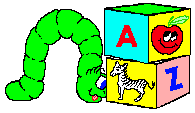
Building Blocks to Reading
Phonics & Whole Language
The two basic philosophies on how to teach reading. We will examine the two basic philosophies used to teach reading, whole language and phonics.
Phonics is the oldest method of teaching reading. Phonics is the systematic teaching of the mechanics of written language. That is the teaching of letter sounds, letter combination sounds, the rules of putting these combinations together, and then sounding them out to make word, sentences, and ideas.
Phonics seems to work well with most children. However if phonics is used in isolation or used in an inappropriate manner, children can misunderstand what reading is all about. For example, young children should not sit with a deck of flash cards for extended periods of time to drill phonics facts into their minds. Such inappropriate activities can cause a young child to decide they don't like to read and so avoid every opportunity to try reading. You can teach a child the mechanics of written language; but, without exposure to fine children's literature they may not develop that love of learning we want for all our children.
Whole Language is the most widely used method in US schools today. It is based on the philosophy that learning to read is a natural step in language development and that children will learn to read as naturally as they learned to speak.
When a child is born we begin to immerse him in spoken language. We coo, babble, and talk to and around our children from the day they are born. Almost every moment of their lives, they are surrounded by spoken language from radio, TV, siblings and adults. We immerse them in spoken language and they naturally learn to speak.
Whole Language has extended this process into reading. If we immerse a child in written language he will naturally learn to read. If we read to a child daily, label things, involve him in reading and writing activities, and immerse him in written language, he will learn to read just as simply and as naturally as he learned to speak.
A child who is read to often, but is taught no phonics, may one day pick up his favorite book and "read" his mother the picture story. The next thing you know, the child is really reading. This is how whole language works in a perfect world. However, whole language alone seems to break down when children at-risk are added to the picture.
Both of these philosophies seem to be valid methods for teaching children to read. The philosophy of most educators is a combination of whole language and phonics. Whole language and phonics can go hand-in-hand. We can use the best of both worlds to help our children achieve a love of learning that can last them their entire lives. A child should be immersed in written language and should also be taught the basic mechanics of written language.
Go Back to the "Learning Train" Home Page.
Go to the next article Children at-risk. Sally's Story.
Please email your comments or suggestions.
Page
Search Puzzles
since April 24, 1998